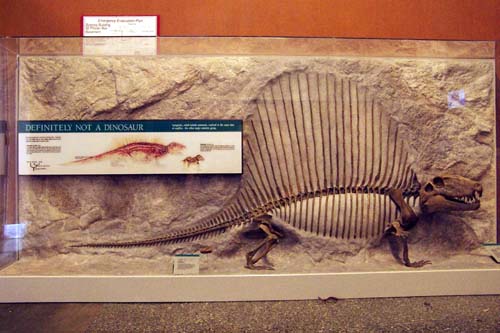|
DEFINITELY NOT A DINOSAUR
Transcript of Panel Text and Description of its Pictures Follows
Synapsids, which include mammals, evolved at the same time as reptiles -- the other major amniote group.
The ancestral synapsid was a meat-eater with large teeth. A single hole in the skull, behind each eye socket, allowed elegant new jaw muscles (smaller but stronger) plenty of room for action.
Dimetrodon (dye-MEE-tro-don)
This synapsid (Dimetrodon limbatus) is among the largest of the early synapsids, ten-foot long. Its upright, fleshy sail was over three feet tall. 250 million years ago, this individual roamed the flooplains of the region we now call Texas, using its double fangs to spear prey. This synapsid's fleshy sail probably attracted potential mates, and also may have absorbed heat to help regulate body temperature. Big teeth and efficient jaw muscles enabled Dimetrodon to process large prey. An arched palate let air flow over food in its mouth and reduced chewing stresses. A bony extension of the lower jaw received airborne sounds.
Thrinaxodon (thrin-AX-o-don)
This active, lightly built synapsid was a fast runner with nearly upright posture. A meat-eater, it had a secondary palate in its upper jaw, so that it could chew and breathe at the same time. Thrinaxodon fossils, 240 to 230 million years old, have been unearthed in Antarctica and South Africa.
PICTURE CAPTIONS
- Dimetrodon (These early synasids represent the lineage that led to mammals -- same one as fossil cast)
- Thrinaxodon -- This early synapsid, about the same size as a modern weasel, lived 230 million years ago in South Africa. It had teeth of different sizes and shapes: front incisors for nipping; sharp, pointed canines for stabbing and tearing; cheek teeth at the back of the jaw for crushing and grinding.
- Diagram showing common ancestry and evolution of Dimetrodon, Thrinaxodon, and mammals from organisms with a single opening in skull behind eye. Evolution of longer limbs, positioned under body, is where thrinaxodon and mammals branch off.
(Access a PRINT VERSION of this page.)
(Return to HOME PAGE).
|
